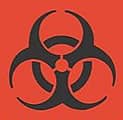This is the 8th anniversary of National Biosafety and Biosecurity Month, an event sponsored by the American Biological Safety Association (ABSA). The theme for 2021 is innovation in biosafety and biosecurity. One topic of focus for the event is the development of, and creativity in, conducting risk assessments. This is the perfect time to review risk assessment practices at your facility!
Biological risk assessments are critical in selecting the correct biosafety containment level and appropriate laboratory controls and practices. They involve identifying the hazardous characteristics of the biological material, identifying work practices that have the potential to create exposure hazards, and addressing the consequences of exposure.
In conducting a risk assessment, factors to consider include the infectious dose and virulence of the biological agent; likely routes of exposure; viability in the lab environment; availability of suitable disinfectants and prophylactics; the scale of work; and experience of lab personnel.
Section II of the 6th edition of the BMBL includes a six-step process for conducting a risk assessment. The steps outlined are:
- First, identify the hazardous characteristics of the agent and perform an assessment of the inherent risk, which is the risk in the absence of mitigating factors including its ability to infect and cause disease and the availability of preventive measures and effective treatments.
- Second, identify laboratory procedure hazards including equipment and procedures that generate small particle aerosols and larger airborne particles (droplets), and the use of sharps.
- Third, make a determination of the appropriate biosafety level and select additional precautions indicated by the risk assessment including work practices, safety equipment, and facility safeguards.
- Fourth, before implementation of the controls, review the risk assessment and selected safeguards with a biosafety professional, subject matter expert, and the IBC or equivalent resource.
- Fifth, as part of an ongoing process, evaluate the proficiencies of staff regarding their ability to follow safe microbiological practices and correctly use safety equipment.
- Sixth, revisit the risk management process and strategies regularly and determine if changes are necessary. Per the BMBL, this step is critical as a cyclical and adaptable risk management process forms the basis for a robust culture of safety in the biological laboratory.
For more information on National Biosafety and Security Month, or for assistance with conducting risk assessments at your facility, please email [email protected].
This blog was written by Beth Graham, our Associate Director of Quality, Research, and Training.

